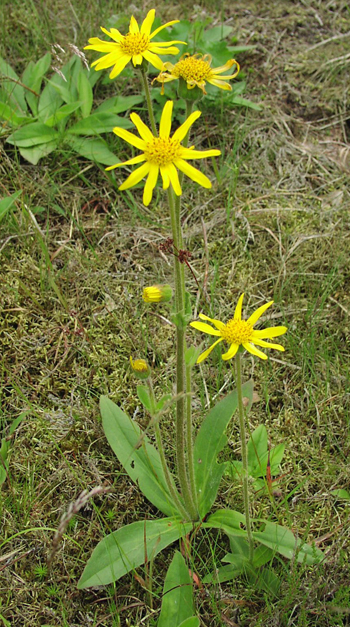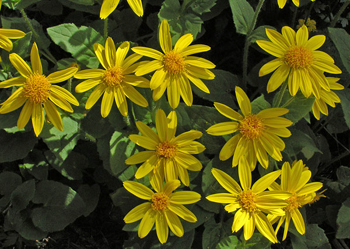Contents:
Common Names | Parts Usually Used | Plant(s) & Culture | Where Found | Medicinal Properties
Legends, Myths and Stories | Uses | Formulas or Dosages | Warning | Bibliography
Scientific Names

- Arnica montana L.
- Compositae
- Composite family
Common Names
- Arnica flowers
- Arnica root
- Common arnica
- Leopard’s bane
- Mountain arnica
- Mountain tobacco
- Wolfsbane
Parts Usually Used
Flowers, rootstock
Back to Top
Description of Plant(s) and Culture

Arnica is a perennial plant; the horizontal, brown, branched rootstock sends up a slightly hairy, simple or lightly branched stem that reaches a height of 1-2 feet. The basal leaves are oblong-ovate and short-petioled; the upper leaves are smaller and sessile. Each plant has 1 to 9 large, yellow, daisy-like flowerheads,
Other varieties: A. fulgens, A. sororia, A. cordifolia, etc.
Back to Top
Where Found
Found in mountainous areas of Canada, the northern United States, and Europe. A European native.
Back to Top
Medicinal Properties
Diaphoretic, diuretic, emollient, expectorant, stimulant, vulnerary
Back to Top
Legends, Myths and Stories
Arnica montana was used in Russian Folk medicine.
Arnica is on the list of strictly protected plants since it is threatened with extinction. Please respect this.
Back to Top
Uses
Arnica is used externally mostly. Used as a salve or tincture, helps heal wounds, bruises, arthritis, and irritations. Only very dilute solutions of the tincture should be used (the herb can cause blistering and inflammation). Used as a poultice but not often. Native Americans used the ointment for stiffened, cramped muscles, poor appetite, hair loss, and arnica tincture to open wounds and gashes, sprains.
Back to Top
Formulas or Dosages
Use professionally prepared remedies when possible.
Infusion: use
External wash: steep
Tincture: use a dilute solution of
Ointment: heat
Back to Top
Warning
One reference cautions not to use arnica on broken skin.
The herb can cause blistering and inflammation. An irritant to the stomach and intestines, can cause serious damage to the heart; and fatalities from poisoning have been reported.
Arnica should not be used for any purpose without medical supervision.
Back to Top
Bibliography
![]() American Folk Medicine
American Folk Medicine, by Clarence Meyer, Meyerbooks, publisher, PO Box 427, Glenwood, Illinois 60425, 1973
![]() The Complete Medicinal Herbal
The Complete Medicinal Herbal, by Penelope Ody, Dorling Kindersley, Inc, 232 Madison Avenue, New York, NY 10016, First American Edition, copyright 1993
 The Healing Plants
The Healing Plants, by Mannfried Pahlow, Barron’s Educational Series, Inc. 250 Wireless Blvd., Hauppauge, NY 11788, 1992
![]() The Herb Book
The Herb Book, by John Lust, Bantam Books, 666 Fifth Avenue, New York, NY. copyright 1974.
 Earl Mindell’s Herb Bible
Earl Mindell’s Herb Bible, by Earl Mindell, R.Ph., Ph.D., Simon & Schuster/Fireside, Rockefeller Center 1230 Avenue of the Americas, New York, New York 10020
Herbal Gardening, compiled by The Robison York State Herb Garden, Cornell Plantations, Matthaei Botanical Gardens of the University of Michigan, University of California Botanical Garden, Berkeley., Pantheon Books, Knopf Publishing Group, New York, 1994, first edition
![]() Indian Herbalogy of North America
Indian Herbalogy of North America, by Alma R. Hutchens, Shambala Publications, Inc., Horticultural Hall, 300 Massachusetts Avenue, Boston, Massachusetts 02115, 1973
![]() The Nature Doctor: A Manual of Traditional and Complementary Medicine
The Nature Doctor: A Manual of Traditional and Complementary Medicine, by Dr. H.C.A. Vogel; Keats Publishing, Inc., 27 Pine Street (Box 876) New Canaan, CT. 06840-0876. Copyright Verlag A. Vogel, Teufen (AR) Switzerland 1952, 1991
 The Rodale Herb Book: How to Use, Grow, and Buy Nature’s Miracle Plants (An Organic gardening and farming book)
The Rodale Herb Book: How to Use, Grow, and Buy Nature’s Miracle Plants (An Organic gardening and farming book), edited by William H. Hylton, Rodale Press, Inc. Emmaus, PA, 18049., 1974
![]() Webster’s New World Dictionary
Webster’s New World Dictionary, Third College Edition, Victoria Neufeldt, Editor in Chief, New World Dictionaries: A Division of Simon & Schuster, Inc., 15 Columbus Circle, New York, NY 10023
![]() The Yoga of Herbs: An Ayurvedic Guide to Herbal Medicine
The Yoga of Herbs: An Ayurvedic Guide to Herbal Medicine, by Dr. David Frawley & Dr. Vasant Lad, Lotus Press, Twin Lakes, Wisconsin, Second edition, 1988.
